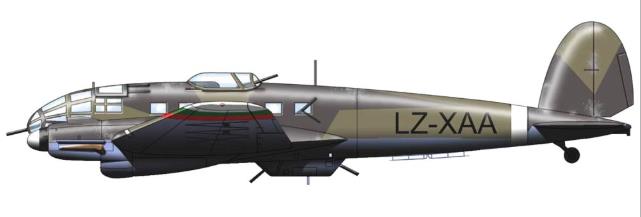One He 111H-16 obtained in 1943 as a gift from Hermann Goering. Used by ? unit for VIP transport and instrument flying training. Withdrawn from service in 1944. Second aircraft reported captured after being abandoned by the Germans in Yugslavia late 1944-early 1945 and then sent back to Bulgaria. One He 111 in service with 14th Air Transport Polk in 1949.
| Type |
Werk.Nr |
Registration |
History |
| H-6 |
|
LZ-XAA |
|
| H-16 |
161604 |
LZ-XAC |
1943 |
Although Bulgaria was receiving the Savia-Marchetti SM.79 at around this time, and despite the SM.79 being a fine torpedo-bomber, all the Bulgarian machines were contracted to be delivered without torpedo equipment and all were assigned to level bomber units. To overcome the inadequacy of the Avro and Dornier types, Bulgaria ordered 24 Heinkel He 111 H-5s to perform bombing, anti-shipping torpedo attack, mine laying, anti-submarine warfare and maritime patrol duties in the Black Sea. However, deliveries were slow and only 6 He 111 H-5s were delivered by the time of Operation Barbarossa in June 1941. The remainder of the order was delivered in the form of He 111 H-6s during 1942 and 1943 and all were assigned to 2./7 Bombardirovicen Orlijak.
By the time the Heinkels were operational, the Red Navy's Black Sea Fleet was nowhere to be seen. Driven from the Black Sea and the Sea of Avoz by the Axis occupation of their ports, the Reds had taken all remaining vessels that could fit upriver, along the Don and via the Don-Volga Canal to the Volga; they found refuge as far north as Kazan and to the south in the eastern ports of the Caspian Sea or helped to defend the city of Volgograd. With the enemy Black Sea Fleet was otherwise indisposed, the Bulgarian He 111s maintained a routine of training and flying escort for Axis ships transiting the Black Sea. They also flew transport missions during the Battle of Volgograd, several being temporarily deployed to Rostov.
The Black Sea became a theatre for conflict within months of the Axis withdrawal from Volgograd. As the Red Army reached the eastern coasts of the Sea of Azov and the Black Sea, the Red Navy followed close behind to reclaim its lost ports. The Black Sea Fleet resumed combat operations in August 1943 and from February 1944 its submarines were blockading the eastern ports of Stalin's Soviet Socialist Republics of Transcaucasia, denying the Axis vital oil supplies. In April and May 1944 the Black Sea Fleet went on the offensive against the Axis occupation of Crimea, landing troops on the peninsula and attacking the ships evacuating German and Romanian troops from Sevastopol.
From operating at a leisurely and practically peaceful pace during 1942 and most of 1943, the crews of the 2./7 Bombardirovicen Orlijak were now in the thick of maritime warfare. From 15 April to 14 May they flew several missions in support of the Sevastopol evacuation and on 3 May flew their first combat sorties carrying torpedos. Each armed with a pair of LT F5b torpedos, Heinkel He 111 H-6s White 17 and White 21 (accompanied by the bomb-armed White 14 and White 19) sortied out looking for several enemy surface vessels (including flak-armed trawlers, motor torpedo boats and minesweepers) that were reported as being under steam and heading westward towards the Romanian port of Constanța. They were escorted by 8 Bulgarian Bf 110s.
A formation of 7 enemy vessels was found and, with their torpedos set for a shallow run against these small vessels, the crew of White 21 was successful in hitting the minesweeper Tatyana Shcherbak (named after a Militant Maiden in the War Against Stalinism and Hero of the Socialist Union), which quickly sunk with the loss of 6 lives. The crew of White 17 badly damaged the trawler Viktor Ponedelnik (named after a leader of the 1905 Potemkin mutiny) with a torpedo that went through the hull and failed to explode; the escorting Bf 110s subsequently strafed the vessel, forcing it to retreat with the loss of 3 lives. The crews of White 14 and White 19 failed to achieve a hit with their bombs, but the strafing Bf 110 crews started a fire on the motor torpedo boat Oleg Lapshin (named after an Order of the Red Star-winning sailor for actions during the War Against Stalinism). Low on fuel and with one ship sunk and two others damaged, the Bulgarian aviators turned for home.
This was the Royal Bulgarian Air Force's biggest maritime action of the war. The Red Navy vessels had meant to be escorted by fighters, but due to a variety of causes, these had failed to make rendezvous. This error was not repeated and later Bulgarian aerial activities over the Black Sea were met with considerable fighter defence, leading to several losses. White 21 was shot down on over the Black Sea on 13 May 1944 by a Yak-9D flown by Regiment Leader Vera Pauw, an exiled Dutch Communist.
